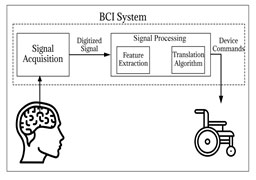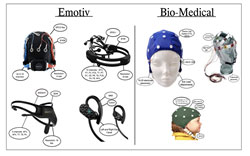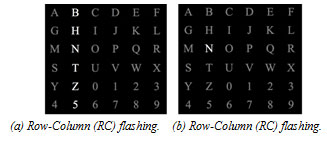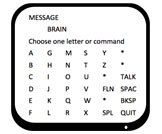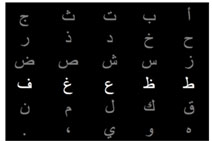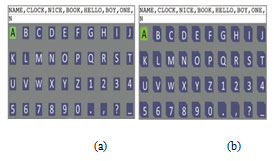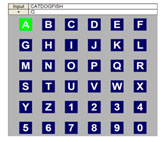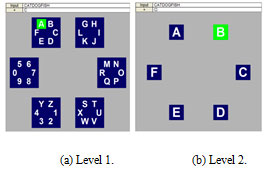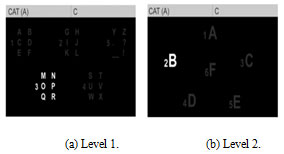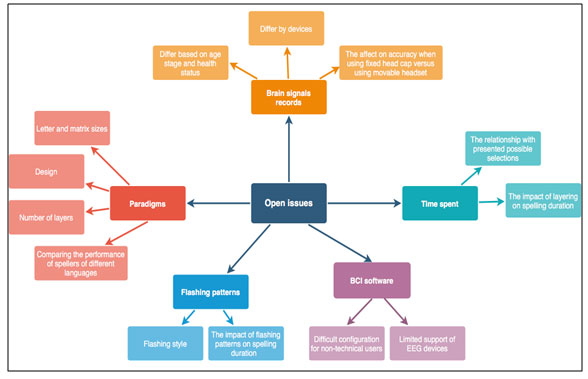1Departmet of Information Technology, College of Computer, Qassim University, Buraydah, Saudi Arabia
2Computers and Control Engineering Dept., Faculty of Engineering, Tanta University, Egypt
Corresponding author email: Saraalrumih@gmail.com
Article Publishing History
Received: 14/07/2020
Accepted After Revision: 25/09/2020
People with Locked-In Syndrome (LIS) have neuromuscular disabilities. Due to these lost and other situations, the concept of Brain-Computer Interface (BCI) established which translates brain wave activity to meaningful commands and helps to obtain direct connection between human brain activity and the world. It is the process of digitizing brain signals to perform specific commands on an external device. One of the BCI popular applications is the BCI speller especially the P300 speller that provides an alternative communication way for people with neuromuscular disabilities. It contains a screen of characters represented as a matrix, by which patients can select a character from it based on an Event-Related Potential (ERP) response that appears in their brain waves activity as a positive-going wave within about 300 milliseconds after selecting a desired character i.e. target, during the spelling process.
In this review, we attempt to illustrate different versions of P300 spellers and describe the different paradigms of P300 speller by classifying them according to the spelling medium, the number of layers, and the flashing patterns. These paradigms including Audio P300 Speller Paradigm, Visual P300 Speller Paradigm, Visual Uni-modal P300 Speller Paradigm, Visual Bi-modal P300 Speller Paradigm, Visual Multimodal P300 Speller Paradigm, and Audio-visual P300 Speller Paradigm. We conclude this paper with some open issues in different areas, which are brain signals records, flashing patterns, paradigms, spelling duration, and BCI software. Therefore, according to the variety of P300 speller paradigms, many areas can be developed to enhance spelling performance and improve its utilization quality.
Brain-Computer Interface (BCI), P300 Speller, Locked-In Syndrome (LIS), Open Issues
Alrumiah S. S, Alhajjaj L. A, Alshobaili J. F, Ibrahim D. M. A Review on Brain-Computer Interface (BCI) Spellers: P300 Speller. Biosc.Biotech.Res.Comm. 2020;13(3).
Alrumiah S. S, Alhajjaj L. A, Alshobaili J. F, Ibrahim D. M. A Review on Brain-Computer Interface (BCI) Spellers: P300 Speller. Biosc.Biotech.Res.Comm. 2020;13(3). Available from: https://bit.ly/33gKesG
Copyright © Alrumiah et al., This is an open access article distributed under the terms of the Creative Commons Attribution License (CC-BY) https://creativecommons.org/licenses/by/4.0/, which permits unrestricted use distribution and reproduction in any medium, provide the original author and source are credited.
INTRODUCTION
Communication is the most important and simplest way to express feelings and needs in a person daily life. As normal people, it can be done through several ways, such as speaking, writing, etc. People with severe motor disabilities, e.g. Locked in Syndrome (LIS) and Amyotrophic Lateral Sclerosis (ALS), have limited capability of communication or transfer information to others Vidal (2020).
There should be an alternative communication way to help in improving patients’ life quality. As a result of this problem, the concept of Brain-Computer Interface (BCI) innovated which translate brain signals to perform specific commands. Many researches have begun to search, improve this domain, develop algorithms and innovate some applications based on this technology. In order to provide easy ways of communications with people who suffer from severe neuromuscular disabilities.
In the early 1920s, scientists explored that human brain produces electric currents and they were able to measure it by electrodes, which Electroencephalogram (EEG) considers as one of the tools that invented in 1929s which resulted a huge impact in neuroscience Nam et al. (2018). Based on EEG responses, human brain waves can be translated to perform a specific command Naufel & Klein (2020) and Ratcliffe et al. (2020).
BCI applications varies based on their uses, one of the popular BCI applications is BCI speller which will be discussed during this review. BCI spellers differ based on the medium implemented in, flashing patterns used, as well as speller Graphical User Interface (GUI).
This review aims to provide some research areas on enhancing P300 speller by illustrating some of the existing versions of it and discussing the related open issues. The review consists of a background on BCI technology, its classes, types, and platforms in the second section, a detailed explanation of the different P300 spellers in section 3, the fourth section discuss some of P300 speller-based open issues, and a concluding statement.
Brain Computer Interface (BCI) definition and classes: BCI helps to get direct communication between brain activity and an external device to perform an action Schalk et al. (2004). It is the process of digitizing brain signals to perform certain commands on an external device. Brain waves are the main component in the BCI system. The system processing starts with acquiring brain signals, processing these signals then execute a specific action. Figure 1 illustrates the structure of any BCI system in which brain signals are detected by the electrodes on human scalp, skull or within human brain, and are processed to extract desired features which consider as user’s intents. The features are translated to command and operate a device, e.g. a wheelchair, Khairullah et al. (2020).
Figure 1: Basic Structure of any BCI System.
The main aim of any BCI system is to engage users with severe motor disabilities with the society, make their daily life communications easier, and grant smart living space for them Lin & Hsieh (2016). BCI technology is also applied in education for normal people (NeuroSky, n.d.), entertainment Andujar et al. (2019) and Rosca & Leba (2019), and Three-Dimensions (3D) virtual environments Andujar et al. (2019) and Vishwakarma (2020). A BCI system is classified into two classes:
Dependent BCI system: In dependent BCI systems, there is a dependency on the muscular and nervous system in brain signals translating process such as, gaze direction or muscle movement. A simple case of a dependent BCI system, patient spells a word using a matrix with the help of eye tracker device, by focusing the gaze direction on the desired character. When that character flashes a Visual Evoked Potential (VEP) is recorded from the visual cortex in the patient scalp.
Independent BCI system: On the other hand, the independent BCI system relies on patient’s attention i.e. intent, not on the muscular system. For example, using a matrix that flashes to spell a word. When the desired character flashes, a specific change in patient’s brain signals is detected known as P300 Event Related Potential (ERP). This class depends only on user intent while reading brain signals.
MATERIAL AND METHODS
There are three types of BCI systems: invasive, semi-invasive, and non-invasive Gonfalonieri (2018). Table 1 presents an overview of these types. Invasive and semi-invasive BCI systems are mostly used to assist patients with severe neuromuscular disorder diseases such as Parkinson, to live a normal life Adama & Bogdan (2016).
Table 1. The Main BCI System Types.
BCI platforms: During the last four decades, researchers have been giving their attention to BCI systems and platforms Velasco-Álvarez et al. (2019). As a result, they produced several software tools for BCI development and analysis that scientists and researchers can use in their experimental studies. Samples of the software tools will be briefly described in this subsection.
BCI2000: a free open source BCI software built in C++ Schalk et al. (2004). It supports different data acquisition devices, signal processing algorithms, and experimental paradigms. It also allows paradigm customization. The software can be discovered and installed from https://www.bci2000.org.
OpenViBE: a free GUI open source BCI software Arrouët et al. (2005). It consists of modules; their integration develops a full BCI system.
BCILAB: a MATLAB based open source software Kothe & Makeig (2013). This tool used in advancement of the BCI technology studies.
UMA-BCI Speller: a BCI2000 based software Velasco-Álvarez et al. (2019). The aim of producing this software is to provide a GUI MATLAB speller customization tool for non-technical researchers.
Electroencephalogram (EEG): EEG is a way of recording brain waves activity by placing electrodes on the patient scalp Paz & West (2014). Human brain consists of 6 lobes: frontal, parietal, temporal, occipital, cerebellum, and limbic Brain Regions & Functions (2010). Each lobe is responsible for performing many functions. Due to the variety of brain lobes and their functions, there are various electrode channels distributed around human scalp. Electrode layout differ based on the system it follows, 10-20 and 10-10 distribution systems are the most popular followed systems Morley et al. (2016) and Schoenberg & Scott (2011).
Electrode channels cover brain lobes: frontal (F), temporal (T), central (C), parietal (P), and occipital (O). These channels are equally divided into three sections: right, left and center. Channels are named based on the brain lobe and location e.g. F3, F refers to frontal region located in the left side of the scalp as 3 is an odd number. All channels in the left section ends with odd numbers, whereas channels in the right section ends with an even number and centralized channels ends with letter z. Furthermore, there are many EEG products in the market used to record brain signals activity. Figure 2 presents samples of EEG products with some details Bio-medical (2019) and Emotiv (2019).
Figure 2: Some of EEG Devices by Emotiv And Bio-Medical Companies.
BCI spellers (P300 speller): BCI spellers are one of the BCI applications that have been considered by several researchers in both dependent and independent BCI fields Farwell & Donchin (1988). P300 speller is an independent BCI speller. It contains a screen of characters i.e. matrix, by which patients can select a character from it based on an ERP response that appears in their brain waves activity as a positive-going wave within about 300 milliseconds (MS) after selecting a desired character i.e. target, during the spelling process. P300 speller contains three main components: an EEG record device which records brain waves activity, a matrix of characters displayed on a screen, and a BCI software responsible for the processing and returning a feedback.
After placing EEG device on patient’s head, the screen will flash randomly by Single Character (SC), Row-Column (RC), or Region-Based (RB), covering all characters. After 300ms in which the desired character or region flashes, a P300 appears in brain records, the repetition of this appearance result on choosing that character and present it in the feedback bar on the screen, and the process continues till the desired word is displayed in the feedback bar. P300 speller performance depends on two factors: accuracy i.e. the percentage of the correct choices over all selections, and Information Transfer Rate (ITR) i.e. the amount of information transferred by system output measured in bits/trail or flash Lu et al. (2019) and Rezeika et al. (2018).
P300 speller matrix can be any size based on the needs. It also could be unimodal i.e. single layer Fernández-Rodríguez et al. (2019), Kabbara et al. (2015), Li et al. (2019), Qu et al. (2018), Ron-Angevin et al. (2019), and Speier et al. (2018), bi-modal i.e. two layers Pan et al. (2013) and Utsumi et al. (2018), or multi-modal paradigm Warren & Randolph (2019). As well as the flashes could be RB flashes Pan et al. (2013), RC flashes Guger et al. (2009), or SC flashes Guger et al. (2009). P300 speller could be performed visually using flashes Fernández-Rodríguez et al. (2019), Kabbara et al. (2015) Li et al. (2019), Pan et al. (2013), Qu et al. (2018), Ron-Angevin et al. (2019), Salvaris & Sepulveda (2009), Speier et al. (2018), Utsumi et al. (2018), Warren & Randolph( 2019), auditorily Hill et al. (2004), or audio-visual Lu et al. (2019) and Oralhan (2019). This review attempts to discuss the different versions of the visual P300 speller.
Spellers comes in different languages rather than English, in order to cover as many patients as possible, e.g. Arabic Kabbara et al. (2015), Korean Rezeika et al. (2018), and Japanese Utsumi et al. (2018).
RESULTS AND DISCUSSION
P300 speller flashing patterns: P300 speller has many diverse paradigms based on the flashing patterns Guger et al. (2009). Figure 3 illustrates two different flashing patterns RC, and SC. In RC pattern, multiple rows or/and columns flashes randomly. On the other hand, in SC pattern, one random character is flashed at a time.
Figure 3: RC and SC Flashing Patterns in P300 Speller.
Guger et al. (2009) conducted a comparison between the performance of RC and SC P300 spellers with 100 participants. Participants, i.e. subjects, were free to choose the speller type. 81 participants experienced RC speller while 19 participants tested both versions. Subjects were asked to spell predefined words and answering some questions about education, sex, and a question related to their work. The result of this comparison showed that higher accuracy rate recorded in RC speller presented in 72.8%, whereas 55.3% was the recorded accuracy of SC flashing pattern. Moreover, RC pattern resulted a faster spelling process, a character flashes in RC each 28.8s, while in SC it flashes each 54s. Thus, the RC pattern is two time faster than SC pattern. The following subsections will describe the different paradigms of P300 speller by classifying them according to the spelling medium, the number of layers, and the flashing patterns.
Audio P300 Speller Paradigm: An auditory paradigm was developed to offer binary selection for LIS patients Hill et al. (2004). This paradigm relies on user attention to the spoken choice, the choice was heard from either left or right ear. Users hear binary choices; each choice is spoken near a specific side randomly. After number of trails and with the interpreting of EEG records, the desired selection will be identified. Auditory paradigms majorly impact in increasing blind LIS patients’ involvement in communication. However, many artifacts can affect patients’ selection. Thus, complex signals classification is necessary.
Visual P300 Speller Paradigm: The first P300 speller was introduced which is a visual BCI speller paradigm Farwell & Donchin (1988). This paradigm consists of 6*6 matrix that contains the 26 alphabet letters and 1-word controlling commands, presented in a screen to LIS patients as shown in Figure 4. A number of flashes by row or column used to detect the desired character, 12 flashes required to cover all cells, i.e. characters. The spelling process begins with recording patient’s brain waves activity using an EEG device while the matrix flashes. When the desired character flashes a P300 will be detected in the patient’s brain wave records. The selected character will be shown in the screen as a feedback.
Authors experimented their studies on four healthy volunteers in two sessions. In the first session they were asked to spell the word “BRAIN” and then choose the TALK command, to assess practicality of the technology and understand its procedures. All volunteers achieved the first session successfully with 30 trails, i.e. 30 RC flashes for each character, concluded with 6 symbols selection in 180 trails (each trail present for 100 ms). The second session aimed to compare between four classification algorithms to assess their efficiency, the compared algorithms were: Stepwise Discriminant Analysis (SWDA), peak picking, area, and covariance. SWDA showed as the fastest algorithm. The maximum accuracy achieved is 95% at speed 12 bit/min, i.e. 2.3 characters/minute, which could be a slow spelling process.
Figure 4: The first P300 speller paradigm.
Based on the studies we have read about BCI spellers, we noticed a huge involvement in the field of enhancing P300 spellers. Researchers are trying to make improvements in the signal’s classification process, speller paradigm style, and results accuracy.
Visual P300 speller paradigm was originally a single-layer, i.e. Fernández-Rodríguez et al. (2019), Kabbara et al. (2015), Li et al. (2019), Qu et al. (2018), Ron-Angevin et al. (2019), and Speier et al. (2018), then researchers developed efficient paradigm consisting of two-layers, i.e. bi-modal paradigm Pan et al. (2013) and Utsumi et al. (2018). Bi-modal paradigm generates higher spelling accuracy and effective spelling process. Years later, researchers used multi-layers paradigm, i.e. multi-modal, to cover special communications, such as using P300 spellers to communicate in social media application e.g. Facebook Warren & Randolph (2019).
Visual Uni-modal P300 Speller Paradigm: Visual unimodal P300 speller paradigm consists of single layer contains characters Fernández-Rodríguez et al. (2019), Kabbara et al. (2015), Li et al. (2019), Qu et al. (2018), Ron-Angevin et al. (2019), Salvaris & Sepulveda (2009), and Speier et al. (2018). The flashing patterns on this paradigm differ from use to another, it could be RC or SC flashes Guger et al. (2009).
Salvaris & Sepulveda (2009) experienced different visual layouts with eight volunteers to indicate the preferable layout for users. White background, black background, small character size, large character size, and other visual styles are used with RC flashing pattern. One participant preferred the white background and another participant preferred the small character size. However, the remaining six participants did not prefer any specific layout. Thus, we can not specify a specific layout to be the best layout. But we believe that black background increases speller usability as user attention is not as distracted as in bright background colors. Moreover, Ron-Angevin et al. (2019) recorded highest usability with the medium character size.
Speller size has a significant impact on the usability of P300 speller Ron-Angevin et al. (2019). Researchers compared between three different speller sizes in order to study the effect of speller size on the usability of P300 speller in terms of efficiency, effectiveness, and satisfaction. Small, medium, and large speller sizes are used. Twelve volunteers experienced the different speller sizes in six sessions each, while applying RC flashes. Each speller size is experienced twice for each attentional condition, overt and covert. Small and large speller sizes obtained poor results under covert attention, as the distances between characters are too small and too large respectively. Thus, small and large speller sizes considered as complex, tiring, and uncomfortable to its users. Furthermore, the medium speller size was the recommended size, since its results showed it was the most effective, efficient, and satisfied speller size in term of usability.
Kabbara et al. (2015) generated the first Arabic speller, by using a 6*5 matrix represents Arabic letters with RC flashes as illustrated in Figure 5. Eleven healthy participants participated in four sessions. They were asked to spell separated letters during the first and second sessions, while spelling words in the third and fourth sessions. Authors had proved that Support Vector Machine (SVM) classifier is the best feature classifier, after comparing it with other three feature extraction and classification algorithms.
Figure 5: Arabic visual P300 speller.
Speier et al. (2018) improved a language suggestion paradigm by combining a predictive method with a filtering method to enhance the performance of suggestion paradigms. Their goal was to use a filtering method to extend the signal classification for P300 speller to enhance the predictive method results. Twelve healthy volunteers experienced in this experiment, and RC flashes pattern used. During spelling process, suggestions were shown in top of the matrix. Meanwhile, numbers from 1 to 6 disappeared as shown in Figure 6.
Figure 6: Predictive P300 speller. (a) Standard matrix, (b) Suggestion of 6 words of the most likely to choose, while numbers from 1 to 6 are removed, (c) After entering “H” letter, and (d) After entering the second character “E”.
This study resulted in increasing the typing rate by 15.5% Speier et al. (2018). Due to this paradigm, subjects were able to spell a full word once. In contract, there are many limitations and challenges facing language modelling, e.g. words that are not included in vocabulary will not be supported.
Qu et al. (2018) proposed a 3D P300 speller paradigm and compared it with the traditional Two-Dimensions (2D) speller. Both paradigms have the same sizes, SC flashing pattern, and layout in which non-flashed character has a blue background, and whenever a character flashes its background color turns into green as presented in Figure 7. However, 3D paradigm present symbols in cubes, when a cube flashes a 3D motion will be shown. Twelve healthy participants joined in this study; they were asked to wear 3D glasses while experimenting the spelling process with the 3D paradigm. The 3D visual P300 speller recorded improvements on the spelling performance, higher accuracy, and lower user workload than the traditional 2D visual P300 speller.
Figure 7: 2D versus 3D visual P300 speller paradigms.
Although researchers had worked on enhancing the performance of visual P300 speller, it is still inadequate Li et al. (2019). As a consequence, authors developed a new colored smiley icon-faces speller paradigm that relies on user mental effort. A 6*6 matrix contains alphabets and numbers from 0 to 9 is used. SC flashing pattern was followed, but in an alternative flashing appearance, whenever the character flashes, the character will be switched to a colored smiley icon-face as described in Figure 8. Although this paradigm increased the spelling accuracy, it increased the spelling process period.
Figure 8: Colored smiley icon-faces P300 speller paradigm.
Fernández-Rodríguez et al. (2019) focused on stimuli kinds that may enhance the performance of BCI speller. The intention of this paper was to compare the performance of the traditional character-based paradigm with picture-based paradigm as shown in Figure 9.
Figure 9: Picture based P300 speller paradigm.
Fernández-Rodríguez et al. (2019) involved twenty-three participants. Results showed that their paradigm had higher performance than the traditional version. Although picture-based paradigm produces faster spelling process, it has limited spelling choices. It is important to mention that picture-based matrix may not be suitable for all patients due to possibility for the appearance of improper pictures such as violence, or nudity.
Visual Bi-modal P300 Speller Paradigm: Many improvements achieved in speller GUI. Pan et al. (2013) focused on SC paradigm which has been described earlier and RB paradigm. RB was conducted with the arrangement of six characters into six groups in the first level as shown in Figure 10 and 11. Seven healthy volunteers participated in this experiment. With twelve random flashes in first round, each region randomly flipped for 75 ms, users were asked to choose a region that contains the desired character from level 1, after that the second level appears which contains six characters, and each character will be flashed randomly. In order to compare between the two versions, the same conditions were applied.
Figure 10: SC uni-modal P300 speller.
Figure 11: RB bi-modal P300 speller.
Subjects were asked to spell three given words as their first task, while applying 10 trails per character Pan et al. (2013). The second task was testing the performance accuracy in many repeats. Each session contains specific number of runs. In each run, subjects were asked to pay attention to some letters to build specific words. According to the first task, the recorded average accuracy of SC was 84.26% and for RB was 88.57%. For the repeated tasks, RB achieved 90% accuracy rate in 4 repeats while SC required 6 repeats to reach high accuracy. The research resulted that RB speller has better performance than SC according to the achieved accuracy rate.
Duchenne Muscular Dystrophy (DMD) patients suffer from muscle weakness, although they can sometime communicate in many ways, muscle weakness makes it hard for them to use these communication methods continuously Utsumi et al. (2018). Utsumi et al (2018) thought that a BCI communication channel will be suitable for them as it does not require any muscle effort. They developed an RB two layers i.e. bi-modal, visual P300 speller paradigm illustrated in Figure 12.
Figure 12: Japanese RB bi-modal visual P300 speller paradigm. In (a) level 1 presents before flashing, while (b) shows level 1 with flashes, then (c) is selected as level 2, and the target selection presents in (d).
The first level contains 6 regions with 9 characters each Utsumi et al. (2018). Each region flashes randomly, whenever the desired region is detected, the second level will appear with 9 characters. Each character flashes randomly, then the desired character will be selected. Eight DMD patients participated in this experiment and reported accuracy rate of 79.8%. According to the reported accuracy rate, P300 speller may be beneficial for DMD patients.
Visual Multimodal P300 Speller Paradigm: A multimodal P300 speller paradigm was developed to introduce a new communication way with Facebook social media platform by relying on P300 signals only, without any muscle movement required Warren & Randolph (2019). Figure 13 presents the paradigm as they called it “Facebrain”, through this paradigm users are able to do many actions, such as searching, posting posts, chatting with others, and viewing profiles in Facebook.
Figure 13: Visual multimodal P300 speller: Facebrain.
Audio-visual P300 Speller Paradigm: The concept of developing visual P300 speller supported by sound generates a new P300 speller paradigm named as audio-visual P300 spellers Lu et al. (2019) and Oralhan (2019). Oralhan (2019) generated an audio-visual paradigm, and its performance was compared with audio-only paradigm and visual-only paradigm. The structure of the developed audio-visual paradigm is presented in Figure 14. The experiment reported a 90.13% accuracy with audio-visual paradigm, while 78.06% and 54.08% accuracy rates of visual-only and audio-only paradigms respectively.
Figure 14: Audio-visual RB P300 speller paradigm sample 1.
Lu et al. (2019) continued the development of audio-visual spellers. Authors performed a comparison between visual and audio-visual RB P300 speller paradigm. Although the audio-visual paradigm recorded higher accuracy rate, a significant latency rate was recorded due to the focusing on increasing the accuracy. Figure 15 shows the paradigm they used. A summary of the discussed different paradigms of P300 speller is presented in Table 2.
Figure 15: Audio-visual RB P300 speller paradigm sample 2.
Table 2. Summary of different P300 speller paradigms.
| Paradigm Type | Number of Choices | Number of Layers | Flashing Pattern | Number of subjects | Reference |
| Auditory | Two | One | – | 15 healthy | Hill et al. (2004) |
| Visual | Unlimited | One | RC | 4 healthy | Farwell & Donchin (1988) |
| Visual | Unlimited | One | RC | 8 healthy | Salvaris & Sepulveda (2009) |
| Visual | Unlimited | One | RC | 12 healthy | Ron-Angevin et al. (2019) |
| Visual | Unlimited | One | RC | 11 healthy | Kabbara et al. (2015) |
| Visual | Unlimited | One | RC | 12 healthy | Speier et al. (2018) |
| Visual | Unlimited | One | SC | 12 healthy | Qu et al. (2018) |
| Visual | Unlimited | One | SC | 27 healthy | Li et al. (2019) |
| Visual | Unlimited | One | SC | 23 healthy | Fernández-Rodríguez et al. (2019) |
| Visual | Unlimited | Two | SC, RB | 7 healthy | Pan et al. (2013) |
| Visual | Unlimited | Two | RB | 8 patients | Utsumi et al. (2018) |
| Visual | Unlimited | Multilayers | RC | In lab only | Warren & Randolph (2019) |
| Audio-Visual | Unlimited | Two | RB | 7 healthy | Oralhan (2019) |
| Audio-Visual | Unlimited | Two | RB | 18 healthy | Lu et al. (2019) |
Open issues on P300 speller: Regarding to the developments mentioned in previous studies, there are some research areas that researchers could focus on as they may have a major effect in the performance of P300 speller. P300 speller performance could be affected by many factors, such as brain signals records, flashing patterns, paradigms, spelling spent time, and BCI software.
Figure 16 illustrates P300 speller-based open issues. Participants with different age stages and health status could change the brain signals records. In addition, the various EEG devices could modify the acquiring accuracy. Moreover, while many researchers compared between the performance of RC and SC flashing patterns, applying other flashing styles may influence the spelling process. More than that, studying the impact of flashing patterns on spelling duration would be useful in reducing the spelling spent time. Furthermore, modifications on P300 speller paradigm could enhance its performance, e.g. propose new designs, change symbols size, and apply different number of layers. Comparing between spellers of various languages would affect spelling duration due to number of letters. P300 speller spent time could have a relationship with the presented possible selections. Finally, the available BCI software do not support all EEG devices as well as using them may be difficult for non-technical users.
Figure 16: P300 speller-based open issues.
CONCLUSION
In this review, a detailed description of P300 speller paradigms was illustrated and some of its open issues were discussed. Researchers made huge improvement in engaging patients with the community by developing different P300 speller versions. However, according to the variety of P300 speller paradigms, many areas can be developed to enhance the spelling performance and improve patients’ life quality.
REFERENCES:
Adama, S., & Bogdan, M. (2016). Coupling Brain-Computer Interface and Electrical Stimulation for stroke rehabilitation and tremor reduction in Parkinson’s disease. The 13rd International Multidisciplinary Modelling and Simulation Multiconference, Cyprus. pp. 51-57.
Andujar, M., McClinton, W., Laesker, D., Garcia, S., Caprio, D., & Pinto, B. (2019). P300-based 3D brain painting in virtual reality. CHI’19 Extended Abstract, Glasgow, Scotland, UK. pp. 1-6. doi: 10.1145/3290607.3312968
Arrouët, C., Congedo, M., Marvie, L., Fabrice, L., Lécuyer, A., & Arnaldi, B. (2005). Open-ViBE: A three-dimensional platform for real-time neuroscience. Journal of Neurotherapy, 9(1), 3-25. doi: 10.1300/J184v09n01_02
Bio-medical. (2019). Retrieved from https://bio-medical.com. Accessed: Dec. 03, 2019.
Brain Regions and Functions | Ask A Biologist. (2010). Retrieved from https://askabiologist.asu.edu/brain-regions. Accessed: Dec. 03, 2019.
Curtin, A., Ayaz, H., Liu, Y., Shewokis, P., & Onaral, B. (2012). A P300-based EEG-BCI for spatial navigation control. Annual International Conference of IEEE Engineering in Medicine and Biology Society, San Diego, CA, USA. pp.1-4.
Emotiv. (2019). Headset comparison chart. Retrieved from https://www.emotiv.com/comparison/. Accessed: Dec. 03, 2019.
Farwell, L. A., & Donchin, E. (1988). Talking off the top of your head: toward a mental prosthesis utilizing event-related brain potentials. Electroencephalography and Clinical Neurophysiology, 70(6), 510-523. doi: 10.1016/0013-4694(88)90149-6
Fernández-Rodríguez, Á., Velasco-Álvarez, F., Medina-Juliá, M. T., & Ron-Angevin, R. (2019). Evaluation of emotional and neutral pictures as flashing stimuli using a P300 Brain- Computer Interface speller. Neural Engineering, 16(5), 1-12. doi: 10.1088/1741-2552/ab386d
Gonfalonieri, A. (2018). A beginner’s guide to brain-computer interface and convolutional neural networks. Retrieved from https://towardsdatascience.com/a-beginners-guide-to-brain-computer-interface-and-convolutional-neural-networks-9f35bd4af948. Accessed: Dec. 03, 2019.
Guger, C., Daban, S., Sellers, E., Holzner, C., Krausz, G., Carabalona, R., Gramatica, F., & Edlinger, G. (2009). How many people are able to control a P300-based Brain-Computer Interface (BCI)?. Advances in Neural Information Processing Systems, 462(1), 94-98. doi: 10.1016/j.neulet.2009.06.045
Hill, N. J., Lal, T. N., Bierig, K., Birbaumer, N., & Schölkopf, B. (2004). An auditory paradigm for Brain-Computer Interfaces. Advances in Neural Information Processing Systems 17, Vancouver, British Columbia, Canada. pp. 142-145.
Kabbara, A., Hassan, M., Khalil, M., Eid, H., & El-Falou, W. (2015). An efficient P300-speller for Arabic letters. In 2015 International Conference on Advances in Biomedical Engineering (ICABME), Beirut, Lebanon. pp. 142-145.
Khairullah, E., Arican, M., & Polat, K. (2020). Brain-Computer Interface Speller System Design from Electroencephalogram signals with channel selection algorithms. Medical Hypotheses, 109690.
Kothe, C., & Makeig, S. (2013). BCILAB: A platform for Brain–Computer Interface development. Journal of Neural Engineering, 10(5), 1-23. doi: 10.1088/1741-2560/10/5/056014
Li, Q., Lu, Z., Gao, N., & Yang, J. (2019). Optimizing the performance of the visual P300-Speller through active mental tasks based on color distinction and modulation of task difficulty. Frontiers in Human Neuroscience, 13(130), 1-14. doi: 10.3389/fnhum.2019.00130
Lin, J. S., & Hsieh, C. H. (2016). A wireless BCI-controlled integration system in smart living space for patients. Wireless Personal Communications, 88(2), 395-412. doi: 10.1007/s11277-015-3129-0
Lu, Z., Li, Q., Gao, N., Yang, J., & Bai, O. (2019). A novel Audiovisual P300-Speller paradigm based on cross-modal spatial and semantic congruence. Frontiers in Neuroscience 13(1040), 1-13. doi: 10.3389/fnins.2019.01040
Morley, A., Hill, L., & Kaditis, A. G. (2016). 10-20 system EEG placement [PDF]. Retrieved from https://www.ers-education.org/lrmedia/2016/pdf/298830.pdf
Nam, C. S., Nijholt, A., & Lotte, F. (2018). Brain-Computer Interfaces Handbook: Technological and Theoretical Advances. 1st ed. Boca Raton, Florida: CRC Press Taylor and Francis Group.
NeuroSky. (n.d.) Boost your learning effectiveness with the new effective learner + study trainer app. Retrieved from https://vimeo.com/282886384. Accessed: Dec. 03, 2019.
Naufel, S., & Klein, E. (2020). Brain–computer interface (BCI) researcher perspectives on neural data ownership and privacy. Journal of Neural Engineering, 17(1), 016039.
Oralhan, Z. (2019). A new paradigm for region based P300 speller in Brain Computer Interface. IEEE Access, 7, 106618–106627. doi: 10.1109/ACCESS.2019.2933049
Pan, J., Li, Y., Gu, Z., & Yu, Z. (2013). A comparison of P300-speller stimuli presentation paradigms for Brain-Computer Interface. Cognitive Neurodynamics, 7(6), 228-231. doi: 10.1007/s11571-013-9253-1
Paz, J. C., & West, M. P. (2014). Acute Care Handbook for Physical Therapists. 4th ed. St. Louis, Missouri: Elsevier Saunders.
Qu, J., Wang, F., Xia, Z., Yu, T., Xiao, J., Yu, Z., Gu, Z., & Li, Y. (2018). A novel three dimensional P300 speller based on stereo visual stimuli. IEEE Transactions on Human Machine Systems, 48(4), 392-399. doi: 10.1109/THMS.2018.2799525
Ratcliffe, L., & Puthusserypady, S. (2020). Importance of Graphical User Interface in the design of P300 based Brain–Computer Interface systems. Computers in Biology and Medicine, 117, 103599.
Rezeika, A., Benda, M., Stawicki, P., Gembler, F., Saboor, A., & Volosyak, I. (2018). Brain–
Computer Interface spellers: A review. Brain Sciences, 8(4), 1-38. doi: 10.3390/brainsci8040057
Ron-Angevin, R., García, L., Fernández-Rodríguez, Á., Saracco, J., André, J. M., & Lespinet-Najib, V. (2019). Impact of speller size on a visual P300 Brain-Computer Interface (BCI) system under two conditions of constraint for eye movement. Computational Intelligence and Neuroscience, 2019, 1-16. doi: 10.1155/2019/7876248
Rosca, S., & Leba, M. (2019). Design of a brain-controlled video game based on a BCI system. MATEC Web of Conferences, 290, Sibiu, Romania. pp. 1-9. doi: 10.1051/matecconf/201929001019
Salvaris, M., & Sepulveda, F. (2009). Visual modifications on the P300 speller BCI paradigm. Journal of Neural Engineering, 6(4), 1-8. doi: 10.1088/1741-2560/6/4/046011
Schalk, G., McFarland, D. J., Hinterberger, T., Birbaumer, N., & Wolpaw. J. R. (2004). BCI2000: A general-purpose Brain-Computer Interface (BCI) system. IEEE Transactions on Biomedical Engineering, 51(6), 1034-1043. doi: 10.1109/TBME.2004.827072
Schoenberg, M. R., & Scott, J. G. (2011). The Little Black Book of Neuropsychology. 1st ed. New York, USA: Springer Science+Business Media.
Speier, W., Arnold, C., Chandravadia, N., Roberts, D., Pendekanti, S., & Pouratian, N. (2018). Improving P300 spelling rate using language models and predictive spelling. Brain-Computer Interfaces, 5(1), 13-22. doi: 10.1080/2326263X.2017.1410418
Utsumi, K., Takano, K., Okahara, Y., Komori, T., Onodera, O., & Kansaku, K. (2018). Operation of a P300- based Brain-Computer Interface in patients with Duchenne Muscular Dystrophy. Scientific Reports, 8(1753), 4-11. doi: 10.1038/s41598-018-20125-6
Velasco-Álvarez, F., Sancha-Ros, S., García-Garaluz, E., Fernández-Rodríguez, Á., Medina-Juliá, M. T., & Ron-Angevin, R. (2019). UMA-BCI Speller: An easily configurable P300 speller tool for end users. Computer Methods and Programs in Biomedicine, 172, 127-138. doi: 10.1016/j.cmpb.2019.02.015
Vidal, F. (2020). Phenomenology of the locked-in syndrome: An overview and some suggestions. Neuroethics, 13(2), 119-143.
Vishwakarma, R., Khwaja, H., Samant, V., Gaude, P., Gambhir, M., & Aswale, S. (2020, February). EEG Signals Analysis and Classification For BCI Systems: A Review. In 2020 International Conference on Emerging Trends in Information Technology and Engineering (ic-ETITE) 1-6. IEEE.
Warren, B., & Randolph, A. B. (2019). Facebrain: a P300 BCI to Facebook. Information Systems and Neuroscience, Vienna, Austria. pp. 119-124. doi:10.1007/978-3-030-01087-4_14.

